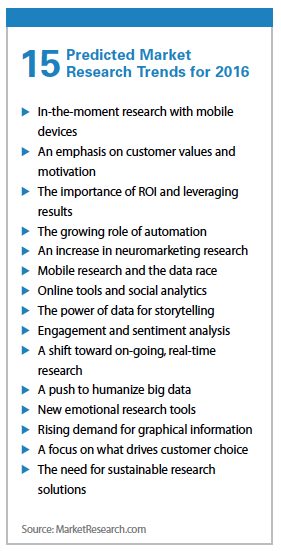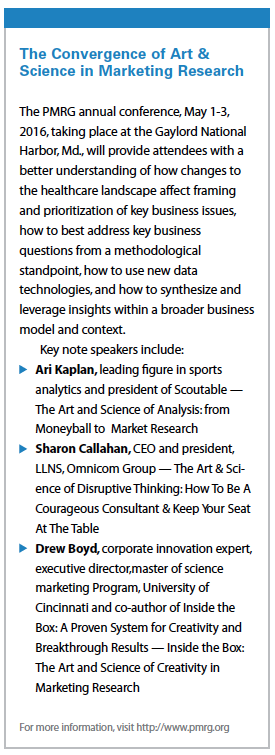MarketResearch.com asked a variety of executives and thought leaders to share their predictions on the trends market researchers should expect in 2016 (see box: 15 Predicted Market Research Trends for 2016). These respondents cited a range of influential factors, including the role of mobile devices, big data, and social analytics in understanding consumer behavior. New technological developments could help market researchers unlock real-time data and answer strategic business questions more quickly and accurately.
There is consensus that in 2016 marketers will continue to use big data to better understand consumer behavior, but market researchers will begin to use the same data to help understand the why behind this behavior, and how they can help marketers develop strategies to impact these behaviors.
 Furthermore, MarketResearch.com reports that in today’s increasingly cluttered marketplace, marketers need to go beyond traditional demographic segmentation to speak to what truly motivates customers to take action — their inner values. In assessing their customer’s values or their inner why, marketers can gain forward looking, rather than backward looking, insights. Additionally, with growing evidence that people cannot accurately predict what they’ll do or explain why they did something, executives say in 2016 there will be an increase in neuromarketing research, supplementing or in some cases supplanting traditional focus groups, surveys, and mall intercepts.
Furthermore, MarketResearch.com reports that in today’s increasingly cluttered marketplace, marketers need to go beyond traditional demographic segmentation to speak to what truly motivates customers to take action — their inner values. In assessing their customer’s values or their inner why, marketers can gain forward looking, rather than backward looking, insights. Additionally, with growing evidence that people cannot accurately predict what they’ll do or explain why they did something, executives say in 2016 there will be an increase in neuromarketing research, supplementing or in some cases supplanting traditional focus groups, surveys, and mall intercepts.
Most experts also agree that market research will increasingly use electronic surveys, video conferencing for interviews with thought leaders, and other technological tools to conduct research.
According to the market research company qSample, the online survey business is booming. It seems everyone is getting in on that quantitative action. Many tech giants are now offering integrated surveys, the latest example being Twitter and its nascent Twitter Polls. The field is getting crowded.
As a result, they report that some studies show participation rates are dropping to an average of 2%, and what’s more this means results are reflecting the views of a tiny minority. They say the answer is not more surveys but better, more customer-exciting execution from market researchers. Furthermore, they say advances in technology, which is driving the recent glut of online surveys, should not mean a less humane approach — after all, tech giants such as Amazon or Apple seem to increase customer experience with every tech evolutionary step. The same should apply to market research. As market research goes fully mobile, more Americans are using mobile devices to browse the Internet than on PCs and already 60% of cell phones are smartphones. qSample advocates that all research should be device agnostic and optimized for mobile by design.
Analysts at GreenBook, which provides insight into the challenges faced by the market research industry, say as ad spending continues to target millennial and centennial consumers, the focus will be on mobile and video — where these generations are plugged in constantly.
These types of advertisements require market researchers to rethink current models of ad testing and incorporate newer technology that can track and monitor how the younger generations respond to advertising on mobile devices.
 Also, they say location-based marketing will likely see a huge increase in 2016. Consumers, especially younger consumers, have developed the ability to effectively ignore marketing that does not directly apply to them. Successful brands and retailers will incentivize engagement with brands through personalized marketing that catches the consumer in their immediate reality — time and place.
Also, they say location-based marketing will likely see a huge increase in 2016. Consumers, especially younger consumers, have developed the ability to effectively ignore marketing that does not directly apply to them. Successful brands and retailers will incentivize engagement with brands through personalized marketing that catches the consumer in their immediate reality — time and place.
GreenBook experts say as brands increase efforts to measure the experiencing-self of consumers along with the remembering-self of consumers that has traditionally been measured, integrating the two becomes critical. Research methodologies like monitoring and ethnography need to be paired with data from survey research to better understand the full picture of what is going on with consumers.
Market research experts say with every patient having a story, the ability to capture these insights is more crucial than ever. Traditional market research tools have limitations in understanding how patients navigate their disease and treatments outside of clinical and pharmacy environments, which is leading to the evolution of closed-looped marketing and research platforms. The data from these programs can provide a powerful channel for pharma companies to deliver patient support, deliver targeted communications and messaging, and generate a wealth of patient informatics for market research and insight mining.
Most market research experts agree that big data will continue to have an impact, noting that storage and processing are cheap, so cheap GreenBook says that companies are able to house and store massive amounts of data for very little cost. Data collection devices have increased the pace of data creation, with IBM estimating that 90% of the data in the world has been created in the last two years. Every transaction, every event imaginable is being logged and recorded. The silos between the data are being destroyed and with the adoption of Hadoop and NoSQL databases, storing, accessing, and combining vast amounts of data while still challenging is a tractable problem.
GreenBook experts say big data represents an enormous challenge for market research, which is historically based on comparably smaller, point of time data sets.
While big data is a disruptor that the pharma industry is fully aware of, it also represents a tremendous opportunity for researchers to incorporate real insights from huge datasets with a wealth of information.When this information is shared, incorporating this performance data into research initiatives not only provides deeper context, but a more well-rounded story. (PV)


















